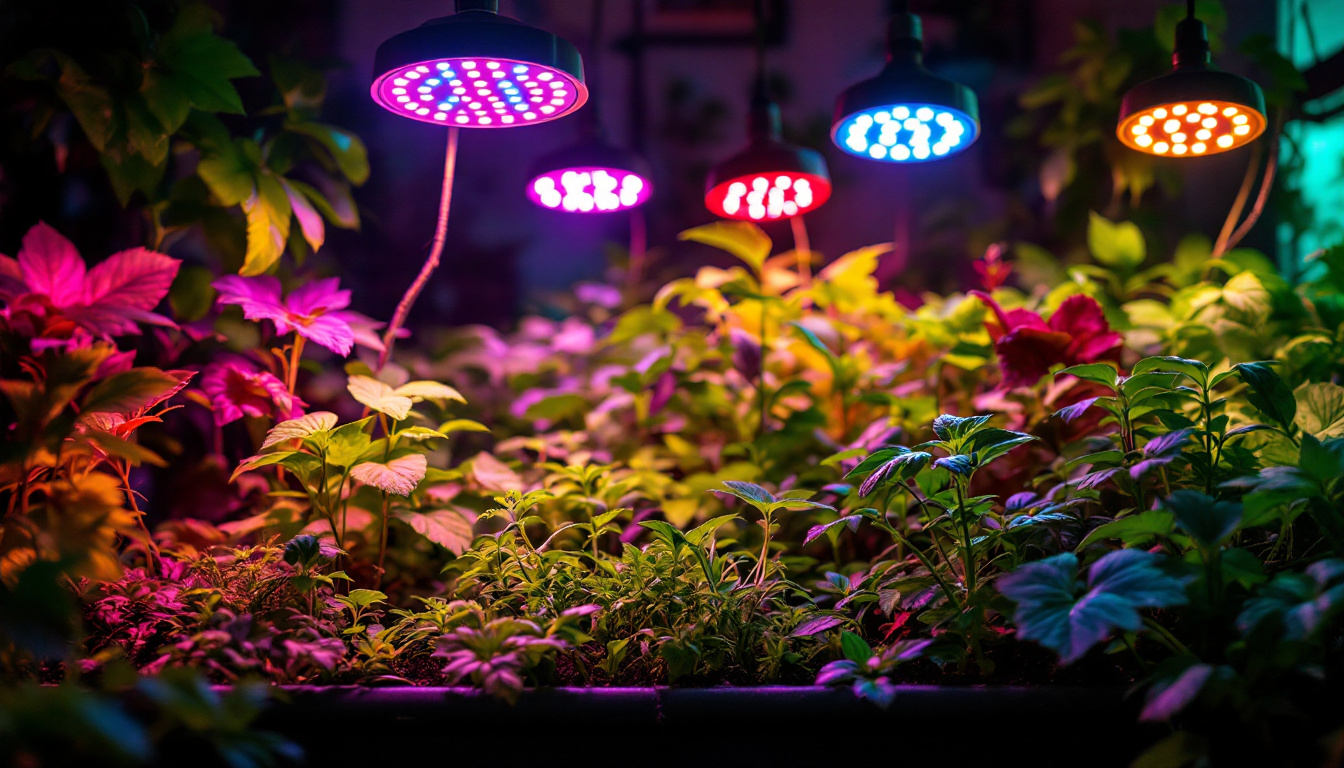
The evolution of lighting technology has significantly impacted various industries, particularly horticulture. LED grow lights have emerged as a game-changer, providing efficient and effective solutions for plant growth. This article delves into insights shared by expert lighting contractors, focusing on the advantages, applications, and considerations when implementing LED grow lights.
One of the most compelling benefits of LED grow lights is their energy efficiency. Unlike traditional lighting systems, which can consume substantial amounts of electricity, LEDs convert a higher percentage of energy into usable light. This efficiency not only reduces energy costs but also minimizes heat output, creating a more stable growing environment.
Lighting contractors emphasize that energy savings can lead to a faster return on investment. As energy prices continue to rise, the economic advantages of switching to LED technology become increasingly apparent. Moreover, lower energy consumption contributes to a reduced carbon footprint, aligning with sustainable practices in horticulture. The reduced heat output also means that growers can save on cooling costs, further enhancing the overall energy savings associated with LED systems. This combination of benefits makes LED grow lights an attractive option for both commercial growers and hobbyists alike.
Another significant advantage of LED grow lights is their ability to provide customizable light spectra. Different plants have varying light requirements at different growth stages. For instance, seedlings thrive under blue light, while flowering plants benefit from red light. LED technology allows for the adjustment of light wavelengths, enabling contractors to tailor lighting solutions to specific crops.
This customization not only enhances plant growth but also improves overall yield quality. Lighting contractors can work closely with growers to design systems that meet the unique needs of their crops, ensuring optimal growth conditions throughout the cultivation cycle. Furthermore, the ability to fine-tune light spectra can help in managing plant stress and promoting healthier growth patterns, which is particularly beneficial for high-value crops. By simulating natural sunlight more accurately, LED grow lights can also help in reducing the time it takes for plants to reach maturity, thereby increasing turnover rates and profitability for growers.
LED grow lights have a longer lifespan compared to traditional lighting options. Most LED systems can last up to 50,000 hours or more, significantly reducing the frequency of replacements. This longevity translates to lower maintenance costs and less downtime for growers.
Additionally, LEDs are more durable and resistant to shock and vibration, making them suitable for various growing environments. Whether in a greenhouse or an indoor farm, the robust nature of LED lights ensures they can withstand the rigors of daily use, providing reliable performance over time. This durability is particularly important in commercial settings where any failure in lighting can lead to significant losses in crop yield. Moreover, many LED grow lights are designed with advanced thermal management systems, which not only enhance their lifespan but also ensure consistent performance, even in challenging conditions. As a result, growers can rely on LED technology to support their operations with minimal interruptions, allowing them to focus on what truly matters: cultivating healthy and thriving plants.
Indoor gardening has gained immense popularity, particularly among urban dwellers with limited outdoor space. Lighting contractors are increasingly called upon to design and install LED grow light systems that cater to indoor gardens. These systems not only support the growth of vegetables and herbs but also enhance the aesthetic appeal of living spaces.
By utilizing LED grow lights, indoor gardeners can cultivate a variety of plants year-round, independent of external weather conditions. This flexibility allows for greater creativity in plant selection and arrangement, making indoor gardening a rewarding hobby or even a viable business opportunity. Additionally, the energy efficiency of LED lights means that indoor gardeners can maintain their setups without incurring exorbitant electricity bills, making it an accessible option for many. The ability to grow fresh produce indoors also promotes a healthier lifestyle, as individuals can enjoy organic herbs and vegetables harvested right from their own homes.
In commercial greenhouse operations, maximizing yield and quality is paramount. Lighting contractors play a crucial role in integrating LED grow lights into greenhouse designs. These systems can be strategically placed to ensure uniform light distribution, promoting even growth across all plants.
Moreover, the use of LED technology in greenhouses can extend the growing season, allowing for earlier planting and later harvesting. This adaptability can lead to increased profits for growers, making LED systems an attractive investment for commercial operations. Furthermore, LED grow lights can be tailored to emit specific wavelengths that are most beneficial for plant growth, enhancing photosynthesis and resulting in healthier plants. As sustainability becomes a key focus in agriculture, the reduced carbon footprint associated with LED lighting also aligns with the goals of environmentally conscious growers, making it a win-win solution for both productivity and ecological responsibility.
Research institutions and agricultural universities are increasingly utilizing LED grow lights in their studies. These facilities require precise control over light conditions to conduct experiments and develop new cultivation techniques. Lighting contractors are tasked with providing systems that can replicate various environmental conditions, enabling researchers to gather accurate data.
By collaborating with research teams, contractors can contribute to advancements in agricultural science, helping to improve crop varieties and cultivation practices. This partnership not only benefits the scientific community but also enhances the reputation of contractors as leaders in innovative lighting solutions. Additionally, the ability to simulate different light spectra allows researchers to explore the effects of light on plant growth, disease resistance, and nutrient uptake. This research is vital for developing more resilient crops that can withstand climate change and other environmental stresses, ultimately leading to a more sustainable food supply for future generations. As these studies progress, the insights gained can lead to breakthroughs that revolutionize the way we approach agriculture, further solidifying the importance of LED grow lights in modern farming practices.
When selecting LED grow lights, one of the primary considerations is light intensity and coverage. Different plants have varying light requirements, and inadequate light can hinder growth. Contractors must assess the specific needs of the crops being cultivated and choose lights that provide sufficient intensity for each growth stage.
Moreover, the layout of the growing area plays a crucial role in determining the number and placement of lights. A well-planned lighting design ensures that all plants receive adequate light, promoting uniform growth and maximizing yields.
While LED lights produce less heat than traditional options, heat management remains a critical factor in grow light systems. Excess heat can stress plants and lead to poor growth outcomes. Contractors should consider the heat output of the chosen LED fixtures and design cooling systems accordingly, especially in enclosed growing environments.
Implementing proper ventilation and air circulation can help maintain optimal temperatures, ensuring that plants thrive under the provided light conditions. This holistic approach to lighting design is essential for successful plant cultivation.
While the initial investment in LED grow lights may be higher than traditional lighting systems, the long-term savings often outweigh the upfront costs. Contractors should provide clients with a comprehensive analysis of the total cost of ownership, including energy savings, maintenance costs, and replacement schedules.
By presenting a clear financial picture, contractors can help clients make informed decisions about their lighting investments. Additionally, exploring financing options or incentives for energy-efficient upgrades can further alleviate the financial burden on growers.
The landscape of LED grow lights is continually evolving, with technological advancements paving the way for even more efficient and effective solutions. Innovations in smart lighting systems, which can be controlled remotely and programmed for specific growth cycles, are becoming increasingly popular.
These smart systems allow for precise monitoring and adjustments, ensuring that plants receive optimal light conditions at all times. As technology continues to advance, lighting contractors must stay informed about the latest developments to provide their clients with cutting-edge solutions.
As the agricultural sector embraces automation and data-driven practices, the integration of LED grow lights with other technologies is on the rise. For instance, combining LED lighting with hydroponic systems or climate control technologies can create a fully optimized growing environment.
Contractors who can offer integrated solutions that encompass lighting, irrigation, and environmental control will be well-positioned in the market. This holistic approach not only enhances plant growth but also streamlines operations for growers, resulting in increased efficiency and productivity.
As sustainability becomes a central focus in agriculture, the role of LED grow lights in reducing environmental impact cannot be overstated. By consuming less energy and producing less waste, LEDs contribute to more sustainable farming practices.
Lighting contractors have an opportunity to champion these sustainable practices by promoting LED technology to their clients. Educating growers about the environmental benefits of LED lights can foster a culture of sustainability within the industry, ultimately leading to a more responsible approach to agriculture.
LED grow lights represent a significant advancement in horticultural lighting technology, offering numerous advantages for growers and lighting contractors alike. From energy efficiency and customizable light spectra to their applications in various growing environments, the benefits of LED systems are clear.
As the industry continues to evolve, staying informed about the latest trends and technologies will be crucial for lighting contractors. By embracing LED grow lights and understanding their impact on plant growth, contractors can position themselves as leaders in the field, providing valuable solutions that meet the needs of modern agriculture.
In conclusion, the insights shared by expert lighting contractors highlight the transformative potential of LED grow lights. By leveraging these technologies, growers can achieve greater success, while contractors can enhance their service offerings, ultimately contributing to a more sustainable and productive agricultural landscape.
Ready to harness the transformative power of LED grow lights and elevate your horticultural projects? Look no further than LumenWholesale for your lighting needs. We provide contractors with exceptional, spec-grade lighting products at the most competitive wholesale prices. By choosing us, you eliminate the middleman and enjoy superior lighting solutions that meet rigorous industry standards. Plus, with the convenience of free shipping on bulk orders, you can rest assured that you’re getting premium lighting at the best value — all without hidden fees or quality compromises. Make the smart choice for your next project and experience the best in wholesale lighting with LumenWholesale.

Learn how to install fluorescent light bulbs easily with our expert guide for lighting contractors.

Discover how tracking lights revolutionize safety in lighting installations by providing dynamic illumination and reducing hazards.

Discover innovative strategies that smart lighting contractors use to harness the power of portable LED lighting.

Discover expert tips and insights in our comprehensive guide to selecting the perfect wall mounted exterior lights.